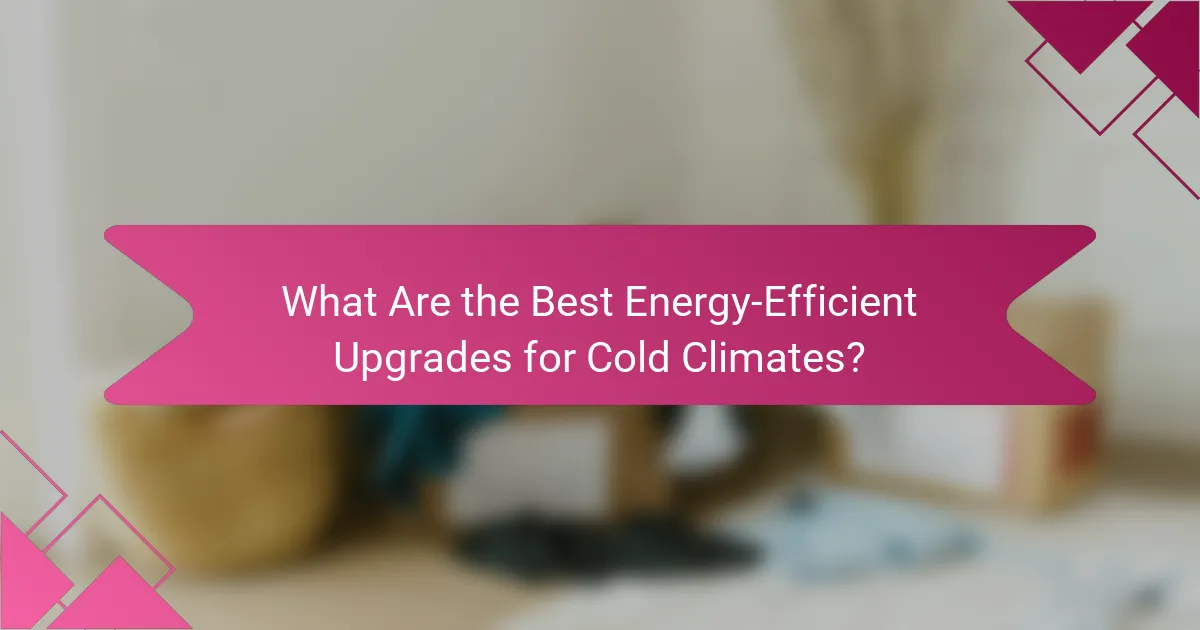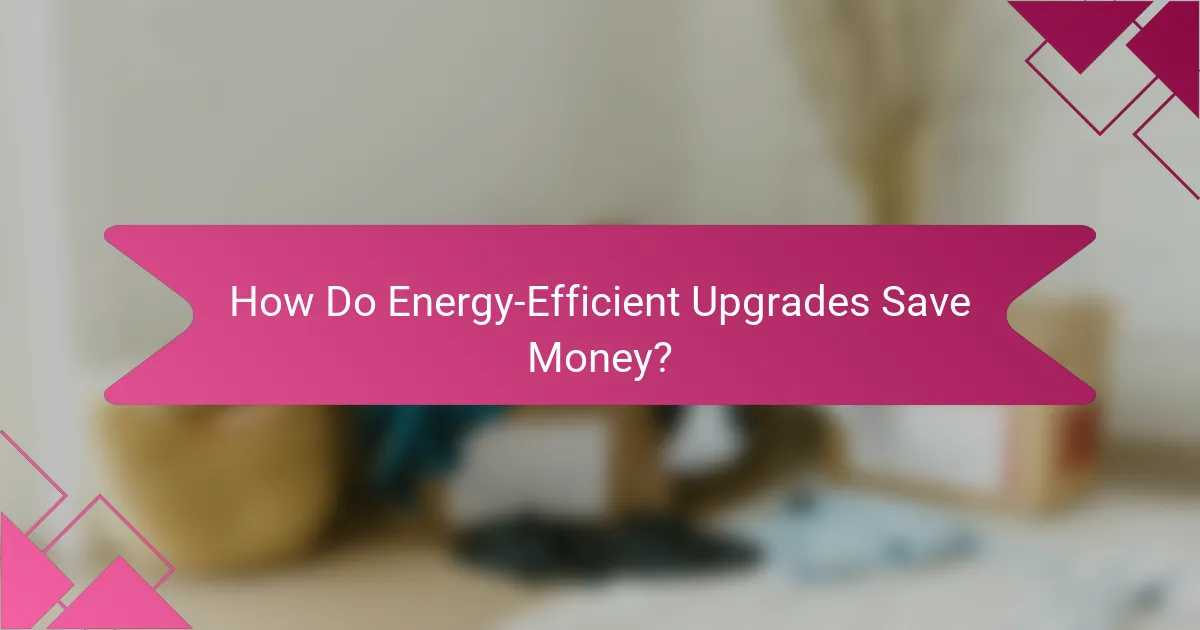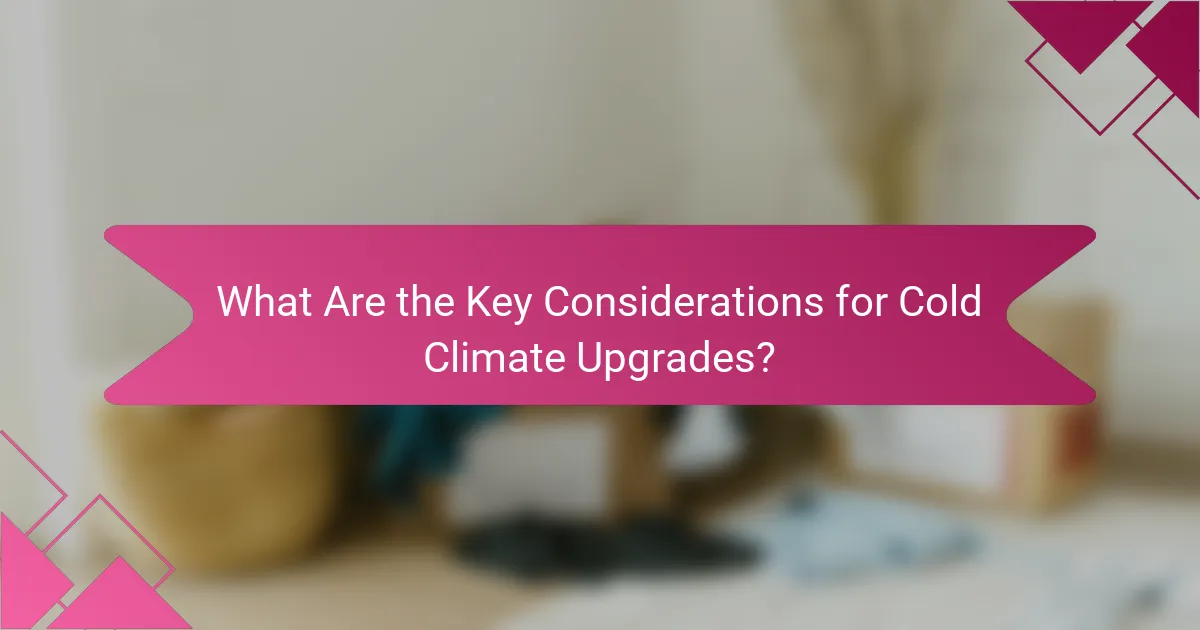Investing in energy-efficient upgrades tailored for cold climates can significantly enhance your home’s insulation and heating efficiency. These improvements not only reduce energy consumption and lower utility bills but also contribute to a more comfortable indoor environment during the winter months. Additionally, homeowners may benefit from financial incentives and an increase in property value, making these upgrades a wise long-term investment.

What Are the Best Energy-Efficient Upgrades for Cold Climates?
The best energy-efficient upgrades for cold climates focus on enhancing insulation, reducing heat loss, and optimizing heating systems. These improvements can lead to significant cost savings on energy bills while maintaining a comfortable indoor environment during harsh winters.
High-Performance Windows
High-performance windows are designed to minimize heat transfer, keeping your home warmer in winter. Look for double or triple glazing, low-emissivity (Low-E) coatings, and gas fills like argon or krypton for improved insulation.
When selecting windows, consider the U-factor, which measures heat loss; lower values indicate better insulation. Energy Star-rated windows are a reliable choice, often providing a return on investment through reduced heating costs.
Insulation Improvements
Improving insulation is crucial for energy efficiency in cold climates. Focus on areas like attics, walls, and basements, where heat loss is most significant. Materials such as fiberglass, foam board, and spray foam can enhance thermal resistance.
For optimal results, aim for insulation levels that meet or exceed local building codes. A common recommendation is R-49 for attics and R-20 for walls, which can drastically reduce heating demands and energy expenses.
Energy-Efficient Heating Systems
Upgrading to energy-efficient heating systems can greatly reduce energy consumption. Options include high-efficiency furnaces, heat pumps, and radiant floor heating, each offering varying levels of efficiency and comfort.
When choosing a system, consider the Annual Fuel Utilization Efficiency (AFUE) rating; systems with AFUE ratings above 90% are ideal. Additionally, explore options for zoning systems to heat only occupied areas, further enhancing energy savings.
Smart Thermostats
Smart thermostats allow for precise control of your heating system, optimizing energy use based on your schedule and preferences. These devices can learn your habits and adjust temperatures automatically, ensuring comfort while minimizing waste.
Many smart thermostats can be controlled remotely via smartphone apps, enabling you to adjust settings when away from home. Look for models that offer energy usage reports to help you identify further savings opportunities.
Air Sealing Techniques
Effective air sealing is essential for preventing drafts and heat loss in cold climates. Common areas to seal include windows, doors, and any gaps around pipes or vents. Using caulk, weatherstripping, and spray foam can significantly improve your home’s energy efficiency.
Conducting a blower door test can help identify leaks in your home. Sealing these leaks can lead to energy savings of 10-20% on heating bills, making it a cost-effective upgrade for maintaining a comfortable indoor climate.

How Do Energy-Efficient Upgrades Save Money?
Energy-efficient upgrades save money primarily by reducing energy consumption, leading to lower utility bills. These improvements can also qualify homeowners for financial incentives and increase property value, making them a smart investment.
Reduced Energy Bills
Upgrading to energy-efficient appliances, insulation, and windows can significantly lower monthly energy bills. For example, replacing old heating systems with high-efficiency models can reduce heating costs by 20-50% during cold months. Additionally, proper insulation can help maintain indoor temperatures, reducing the need for excessive heating.
Consider using programmable thermostats to optimize heating schedules, which can further decrease energy usage. Regular maintenance of heating systems also ensures they operate efficiently, preventing unnecessary expenses.
Tax Credits and Rebates
Many governments offer tax credits and rebates for energy-efficient upgrades, which can offset initial costs. In the United States, for instance, homeowners may receive tax credits for installing solar panels or energy-efficient HVAC systems. These incentives can range from a few hundred to several thousand dollars, depending on the upgrade.
Check local and federal programs to see what incentives are available in your area. Some utility companies also provide rebates for energy-efficient appliances, making it beneficial to research all options before proceeding with upgrades.
Increased Home Value
Energy-efficient upgrades can enhance a home’s market value, making it more attractive to potential buyers. Homes with energy-efficient features often sell for 5-10% more than comparable homes without these improvements. Buyers are increasingly looking for properties that promise lower utility costs and a reduced environmental footprint.
When considering upgrades, focus on high-impact areas such as energy-efficient windows, insulation, and modern heating systems. These improvements not only save money but also contribute to a more sustainable living environment, appealing to eco-conscious buyers.

What Are the Costs of Energy-Efficient Upgrades?
The costs of energy-efficient upgrades can vary widely based on the type of improvements, the size of the home, and local labor rates. Generally, homeowners can expect to invest a few thousand to tens of thousands of dollars, but these upgrades often lead to significant savings over time.
Average Installation Costs
Installation costs for energy-efficient upgrades typically range from a few hundred to several thousand dollars, depending on the project. For example, adding insulation may cost between $1,000 and $3,000, while upgrading to energy-efficient windows can range from $5,000 to $15,000 for a standard home.
Labor costs can vary significantly by region, so it’s essential to obtain multiple quotes from local contractors. Additionally, consider any permits or inspections that may be required, which can add to the overall cost.
Long-Term Savings Estimates
Long-term savings from energy-efficient upgrades can be substantial, often reducing energy bills by 20-50%. For instance, upgrading to a high-efficiency HVAC system can save homeowners hundreds of dollars annually on heating and cooling costs.
Many upgrades also increase property value, providing a return on investment that can exceed the initial costs. Homeowners should evaluate their specific circumstances and energy usage to estimate potential savings accurately.
Financing Options
Various financing options are available for homeowners looking to invest in energy-efficient upgrades. Many local and federal programs offer low-interest loans, rebates, or tax credits to help offset initial costs. For example, the Energy Efficiency Financing Program may provide loans for qualifying improvements.
Home equity loans and lines of credit are also viable options, allowing homeowners to leverage their property value for funding. It’s advisable to compare different financing methods to find the best terms and interest rates that suit your financial situation.

What Are the Key Considerations for Cold Climate Upgrades?
When upgrading for cold climates, key considerations include selecting appropriate materials, adhering to local building codes, and evaluating the return on investment. These factors ensure that upgrades are effective, compliant, and financially viable.
Climate-Specific Materials
Choosing climate-specific materials is crucial for energy efficiency in cold climates. Insulation types, such as spray foam or rigid foam boards, can significantly impact heat retention and energy costs. Additionally, windows with low U-values and triple glazing can minimize heat loss.
Consider using materials that resist moisture and mold, as cold climates often have high humidity levels. For example, vapor barriers can prevent condensation issues that lead to structural damage.
Local Building Codes
Local building codes dictate the standards for energy efficiency and safety in construction. Familiarizing yourself with these regulations is essential, as they may specify insulation R-values, window performance, and ventilation requirements. Compliance not only ensures safety but can also qualify you for local incentives.
Check with local authorities or building inspectors to understand specific requirements in your area. Non-compliance can lead to costly fines and the need for expensive retrofits.
Return on Investment
Evaluating the return on investment (ROI) for cold climate upgrades involves comparing the upfront costs to potential savings on energy bills. Generally, energy-efficient upgrades can yield savings of 20-50% on heating costs, depending on the improvements made.
Consider conducting an energy audit to identify the most cost-effective upgrades. Prioritize projects with the highest ROI, such as improving insulation or upgrading to energy-efficient heating systems, to maximize your investment.

How to Choose the Right Upgrades for Your Home?
Selecting the right energy-efficient upgrades for your home involves assessing your specific needs, climate conditions, and budget. Focus on solutions that enhance insulation, heating efficiency, and renewable energy sources to maximize savings and comfort.
Assess Your Home’s Current Energy Efficiency
Start by evaluating your home’s current energy performance. Conduct an energy audit to identify areas where heat loss occurs, such as windows, doors, and insulation. This assessment helps prioritize which upgrades will yield the most significant benefits.
Consider using tools like thermal imaging cameras or hiring a professional auditor. These methods can reveal hidden issues that may not be apparent, ensuring you address the most critical areas first.
Prioritize Insulation and Sealing
Improving insulation and sealing gaps is often the most cost-effective upgrade. Focus on areas like attics, basements, and crawl spaces, where heat loss is prevalent. Insulation materials like fiberglass, foam board, or spray foam can significantly reduce heating costs.
Additionally, sealing leaks around windows and doors with weatherstripping or caulk can prevent drafts and enhance comfort. Aim for a tight building envelope to maximize energy savings.
Consider Heating System Upgrades
Upgrading your heating system can lead to substantial energy savings. Look for high-efficiency furnaces or heat pumps that meet or exceed ENERGY STAR standards. These systems can reduce energy consumption by up to 30% compared to older models.
Evaluate the type of heating system that best suits your climate. For colder regions, consider systems that provide both heating and cooling, such as ductless mini-split heat pumps, which can be particularly effective in cold climates.
Explore Renewable Energy Options
Incorporating renewable energy sources, such as solar panels, can further enhance energy efficiency. Solar installations can offset a significant portion of your electricity costs, especially in sunny regions. Look for incentives or rebates available in your area to reduce initial costs.
Consider the orientation of your home and local regulations when planning a solar installation. Ensure that your roof can accommodate the panels and that you comply with any zoning or permitting requirements.
Evaluate the Cost-Benefit Ratio
When choosing upgrades, weigh the upfront costs against potential long-term savings. Use tools like payback period calculations to determine how quickly an investment will pay off through reduced energy bills.
Be cautious of over-investing in upgrades that may not yield substantial savings. Focus on improvements with a clear return on investment, such as insulation and efficient heating systems, which typically offer quicker payback times.


